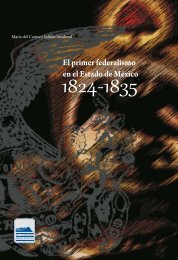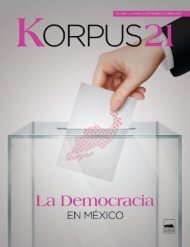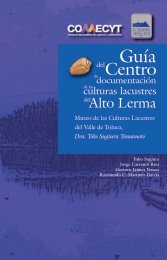Korpus 21 - Vol. 3
Korpus 21 - Nuevas interpretaciones acerca de la consumación de la Independencia.
Korpus 21 - Nuevas interpretaciones acerca de la consumación de la Independencia.
Create successful ePaper yourself
Turn your PDF publications into a flip-book with our unique Google optimized e-Paper software.
JOHN TUTINO, 18<strong>21</strong>: THE END OF NEW SPAIN, DREAMS OF AN IMPOSSIBLE MEXICO<br />
leaders never controlled and struggled to<br />
contain. The merger of regime conflicts and<br />
popular risings destroyed silver had capitalism<br />
by 1812. The challenges that led to the<br />
regime break and the popular risings were<br />
separate, yet simultaneously. Their parallel<br />
development and eventual fusion made the<br />
revolution that broke New Spain.<br />
The regime break came first. The years<br />
after 1790 had brought mounting challenges.<br />
Imperial wars (and revolution in Saint<br />
Domingue) drove rising demand for silver<br />
to fund trade and sustain imperial treasuries<br />
while wartime disruptions rattled production<br />
and trade (Marichal, 1999). Despite<br />
disruptions, New Spain’s silver rose to peak<br />
in 1809. Spanish revenue needs led to the<br />
Royal Consolidation of 1804-1808, calling in<br />
Church mortgages held by New Spain’s estate<br />
operators, who struggled to pay. Still,<br />
leading oligarchs were least affected, the<br />
powerful negotiated settlements, and the<br />
weakest paid most in negotiated outcomes<br />
that fueled worries and resentments yet inhibited<br />
overt resistance (Wobeser, 2003;<br />
Valle Pavón, 2012, 2016; Tutino, 2018b). During<br />
the same decades, drives for profit led<br />
to predatory pressures on producing communities<br />
in key regions, notably the Bajío<br />
basin lands that sustained Guanajuato, and<br />
the Mezquital close by Real del Monte. There<br />
were local conflicts, but again productive<br />
stability held to 1810 (Tutino, 2011, Part 2;<br />
2018a, Ch. 4).<br />
Everything began with Napoleon. Having<br />
lost Saint Domingue to Haitian revolutionary<br />
ex-slaves in 1804, depriving France of key<br />
overseas revenues, Napoleon invaded Iberia<br />
in 1807, imagining taking Portugal and the<br />
revenues of Brazil from his British foe. When<br />
the British transported the Portuguese monarchy<br />
to Rio de Janeiro, in 1808 he invaded<br />
his Spanish ally –dreaming of claiming New<br />
Spain’s silver still flowing toward historic<br />
peaks. As French troops captured Madrid in<br />
early May, Spain’s monarchs, Carlos IV and<br />
Fernando VII, father and son, accepted comfortable<br />
imprisonment in Bayonne. People<br />
and power holders across Spain rose in resistance<br />
–invoking traditional Spanish rights<br />
of the sovereignty of the pueblos. Without a<br />
legitimate monarch (and few accepted Joseph<br />
Bonaparte as legitimate), the pueblos<br />
–towns with councils– regained the sovereignty<br />
delegated by God and met in juntas<br />
to reject the intruder and restore legitimate<br />
rule. They were soon backed by guerrilla<br />
forces that rose to challenge French armies<br />
in key regions (Stein and Stein, 2014; Tone,<br />
1995).<br />
The news of the fall of the monarchy in<br />
Madrid and the rise of resistance across<br />
Spain came to Mexico City as June became<br />
July. Debates in the City Council seeking rights<br />
to join the reconstitution of sovereignty<br />
quickly engaged Viceroy don José de Iturrigaray.<br />
A summer of mobilization saw men<br />
in the halls of power, and men and women<br />
in the streets and plazas of the capital, debate<br />
rights and ways to popular sovereignty:<br />
did it belong to the pueblos of Spanish<br />
traditions, the people of English assertions,<br />
or the nation imagined by French revolutionaries.<br />
All saw the link to Madrid as broken;<br />
all honored Fernando VII as a monarch deprived<br />
of sovereignty; all pressed for autonomies<br />
to shape New Spain’s response in an<br />
uncertain interim (Tutino, 2018b).<br />
As August became September, Iturrigaray,<br />
allies in the city council and regime<br />
offices, and leading members of the Mexico<br />
City financial, commercial, and landed oligarchy,<br />
moved to call a junta or congress<br />
of New Spain. It would exercise sovereignty<br />
and rule silver capitalism in times of imperial<br />
break and peninsular war, empowered<br />
to adapt to changing uncertainties –in the<br />
interest of New Spain.<br />
Then on the night of September 15-16,<br />
1808, military emissaries sent by the Seville<br />
Junta that claimed supremacy in Spain, mobilized<br />
armed power to capture and depose<br />
the Viceroy, blocking any move toward<br />
autonomy for New Spain. Peninsular justices<br />
on the Audiencia backed a coup implemented<br />
by a section of the Mexico City merchants’<br />
militia led by don Gabriel José de<br />
Yermo, a struggling merchant and aspiring<br />
landlord who had lost property to the Consolidation.<br />
The city was occupied by forces<br />
336


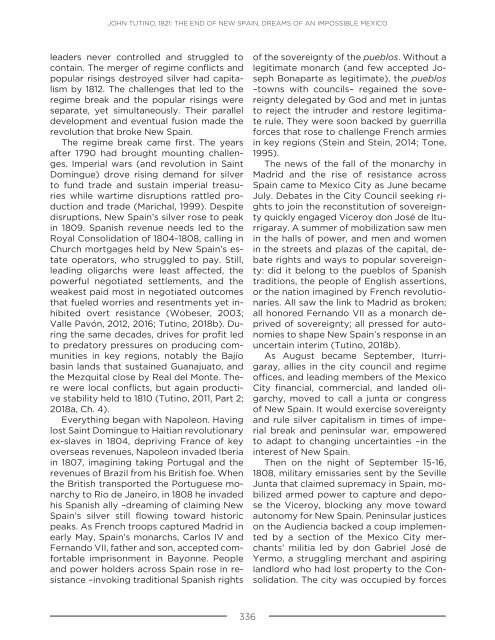
![bicentenario_1[V2]](https://img.yumpu.com/68677971/1/167x260/bicentenario-1v2.jpg?quality=85)
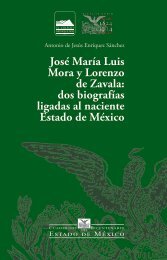
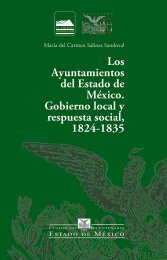

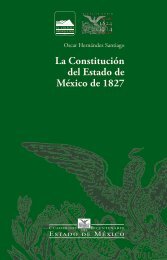
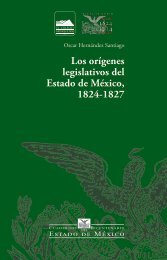
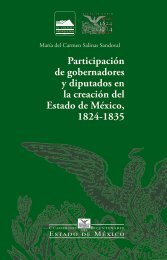
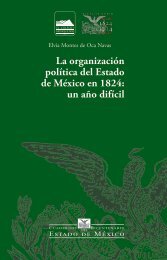
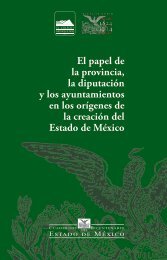

![El_primer_federalismoEM[final]_compressed (2)](https://img.yumpu.com/68483279/1/178x260/el-primer-federalismoemfinal-compressed-2.jpg?quality=85)
